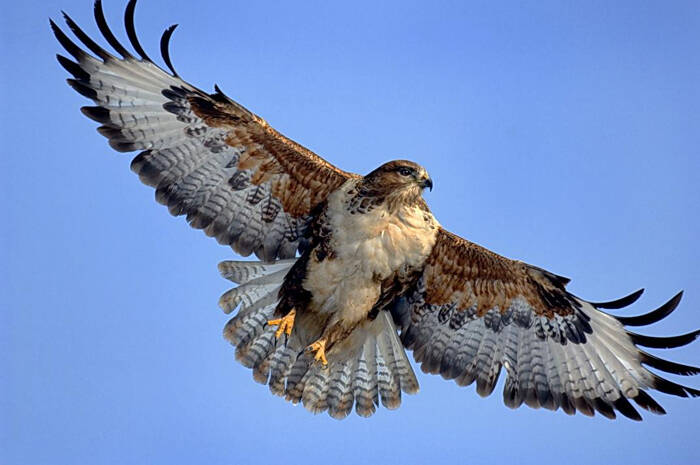Buteo hemilasius
IUCN
LCBasic Information
Scientific classification
- name:Buteo hemilasius
- Scientific Name:Buteo hemilasius,Upland Buzzard,Leopard, egret leopard
- Outline:Raptor
- Family:Falconiformes Accipitridae Buzzard-subfamily Buzzard-genus
Vital signs
- length:57-76cm
- Weight:1.32-2.1kg
- lifetime:20-70years
Feature
Brownish-yellow wings with white spots on the underside when flying
Distribution and Habitat
Origin: Bhutan, China, India, Kazakhstan, Democratic People's Republic of Korea, Republic of Korea, Kyrgyzstan, Mongolia, Nepal, Russian Federation (Central Asia and East Asia), Tajikistan.
Wandering: Hong Kong, Japan, Uzbekistan.
In China, it is distributed in Heilongjiang, Jilin, Liaoning, Inner Mongolia, Tibet, Xinjiang, Qinghai, Gansu and other places as a resident bird, and in Beijing, Hebei, Shanxi, Shandong, Shanghai, Zhejiang, Guangxi, Sichuan, Shaanxi and other places as a migratory bird and winter migratory bird.
It inhabits mountainous areas, plains at the foot of mountains and grasslands, and also appears in alpine forest edges and open mountain grasslands and desert areas. The vertical distribution height can reach plateaus and mountains above 4,000 meters. In winter, it is also often seen in farmlands, reed marshes, villages, and even near cities in low mountains, hills and plains at the foot of mountains.
Appearance
The body color varies greatly, and is divided into two types: dark type and light type. The dark type has dark brown upper body, light brown edges on shoulders and upper wing coverts, slightly lighter feathers on the head and neck, brownish-yellow feather edges, black eyebrow stripes, light brown tail with 6 light brown and white horizontal stripes, white feather shafts and feather edges, dark brown wings, white base of inner vane of flight feathers, dark horizontal stripes on secondary flight feathers and inner coverts, white edges on inner vane with dark spots, and white base of underwing flight feathers, forming white spots. The lower body is light brown with dark feather shaft stripes and horizontal stripes. The leg coverts are dark brown; the light type has almost pure white head and nape with dark feather shaft stripes. The eyes are gray-black, the ear feathers are dark brown, the back, shoulders, and abdomen are dark brown, and the feather edges are brown-white vertical stripes.
Details
The Upland Buzzard is a large bird of prey with no subspecies.

The Upland Buzzard is mainly a resident bird, and some are migratory. In spring, most of them arrive at the breeding grounds in late March or early April, and in autumn, most of them leave the breeding grounds in late October to mid-November. The breeding population in China is mainly resident, and some migrate to the southern part of the breeding grounds for wintering.
The buzzard is usually active during the day. It often moves alone or in small groups. When flying, its wings flap slowly, and it often soars in circles in the air when the weather is warm. In addition, there are also up-flying, down-flying, oblique-hanging flying, straight-line flying, low-flying and turning oblique-hanging tree-flying, flying between trees, short-distance jumping flying, long-distance gliding flying, air-driving flying, chasing and playing, flying to get prey, and various fighting flying methods, which can be said to be varied. It is ferocious and very alert. When resting, it often lives on the ground, on the top of rocks, or on protruding objects in the forest. In winter, it mixes with kites to forage in the forest edge area behind the houses of residents in Songbai Town. Those who find food flap their wings and run away to prevent other birds from coming to compete. When resting, they often live on the ground, on the top of the mountain, on the top of the tree or other protruding objects.
The buzzard mainly feeds on rodents, frogs, lizards, hares, snakes, yellow rats, pikas, marmots, pheasants, partridges, insects and other animal foods. The main hunting method is to hover in the air, or stand on the ground and high places to wait for the prey. It observes and searches with its sharp eyes. Once it finds the prey on the ground, it suddenly dives down quickly and grabs it with its claws. In addition, it also perches on high places such as branches or electric poles to wait for prey, and only pounces when the prey appears in front of it. It has a very advanced technique in catching snakes. After catching them with its feet, it flaps its wings and flies to an altitude of more than 300 meters. The snake, unwilling to surrender, bends its body and prepares to wrap around the feet of the buzzard. However, the buzzard suddenly straightens its legs and claws, lets the snake go, and makes it fall to the ground. Then it swoops down, grabs the snake again, and brings it into the air. It repeats the previous action until the snake loses its ability to resist, then it lands on the ground and slowly devours it.
The breeding season of the buzzard is from May to July. It usually nests on cliffs or trees, and there are mostly small shrubs near the nest. The nest is disc-shaped and can be used for many years, but the nesting materials must be supplemented every year. Therefore, some nests with a longer service life can reach a diameter of more than 1 meter. The nest is mainly made of dry branches, with hay, animal hair, feathers, debris and rags inside. Each nest usually contains 2-4 eggs, and occasionally up to 5. The eggs are light ochre yellow with reddish brown and mouse-gray spots, more at the blunt end. The incubation period is about 30 days. The chicks are late-maturing. After hatching, they are raised by the parents for about 45 days, then fly away from the nest and forage for food alone.
Listed in the 2016 Red List of Endangered Species of the World Conservation Union (IUCN) ver 3.1 - Least Concern (LC).
Listed in the second category of protected animals of China's national key protected wild animals.
Protect wild animals and stop eating game.
Maintaining ecological balance is everyone's responsibility!








